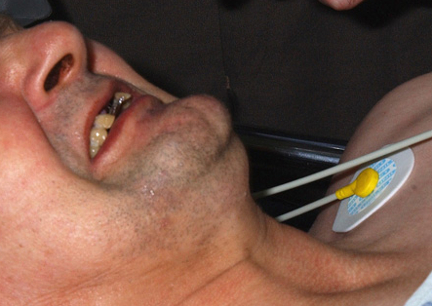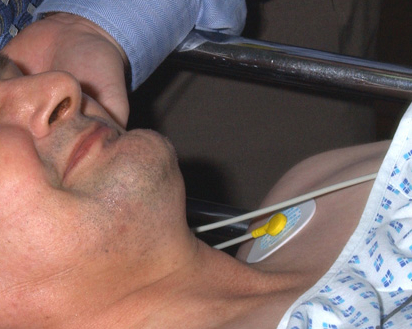Criteria
Generalised
The most common clinical form, frequently presenting with trismus ('lock jaw') due to spasm of the masseter muscle. Repeated painful spasms occur affecting any part of the body. Restlessness, irritability, dysphagia, opisthotonus, and seizures can be seen, as well as respiratory failure due to vice-like contraction of the intercostal muscles or involvement of the glottis or diaphragm.[43][44] Severe autonomic dysfunction may arise after several days.
Generalised tetanus can be further classified according to severity. The grading system described by Ablett is the most widely used:[45]
Grade 1 (mild): mild/moderate trismus and general spasticity, little or no dysphagia, no respiratory embarrassment, no spasms.
Grade 2 (moderate): moderate trismus and generalised spasticity, plus mild dysphagia and fleeting spasms. Moderate respiratory embarrassment may occur.
Grade 3a (severe): severe trismus and generalised spasticity. Severe dysphagia and respiratory difficulties. Severe and prolonged spasms (both spontaneous and on stimulation).
Grade 3b (very severe): as for grade 3a plus marked autonomic dysfunction.[Figure caption and citation for the preceding image starts]: TrismusFrom the collections of Nicholas J. Beeching and Christopher M. Parry [Citation ends].
 [Figure caption and citation for the preceding image starts]: TrismusFrom the collections of Nicholas J. Beeching and Christopher M. Parry [Citation ends].
[Figure caption and citation for the preceding image starts]: TrismusFrom the collections of Nicholas J. Beeching and Christopher M. Parry [Citation ends].
Localised
A rare, milder form with a good prognosis. Muscle spasms are limited to one extremity or body region.
Cephalic
The rarest form; it follows head injury or middle ear infection. Cranial nerve palsies occur that may progress to generalised tetanus. The prognosis is very poor.
Neonatal
A form of generalised tetanus occurring in the first 28 days of life, widespread in the developing world; it is associated with umbilical stump infection in neonates born to mothers who have not been immunised. The mortality rate is high, with infants dying of complications such as central nervous system haemorrhage, pneumonia, pulmonary haemorrhage, and laryngeal spasms.[46]
Maternal
Maternal tetanus is defined as tetanus during pregnancy or within 6 weeks of the end of pregnancy (due to birth, miscarriage, or abortion), and has been associated with increased mortality compared with other types of adult tetanus.[2] Tetanus following abortion carries a particularly high risk of mortality, perhaps because women delay seeking medical attention.[22]
Use of this content is subject to our disclaimer